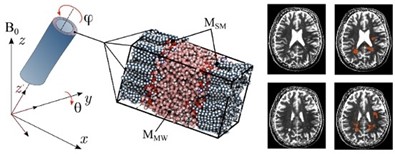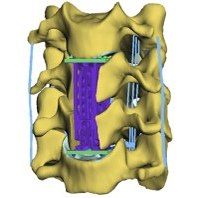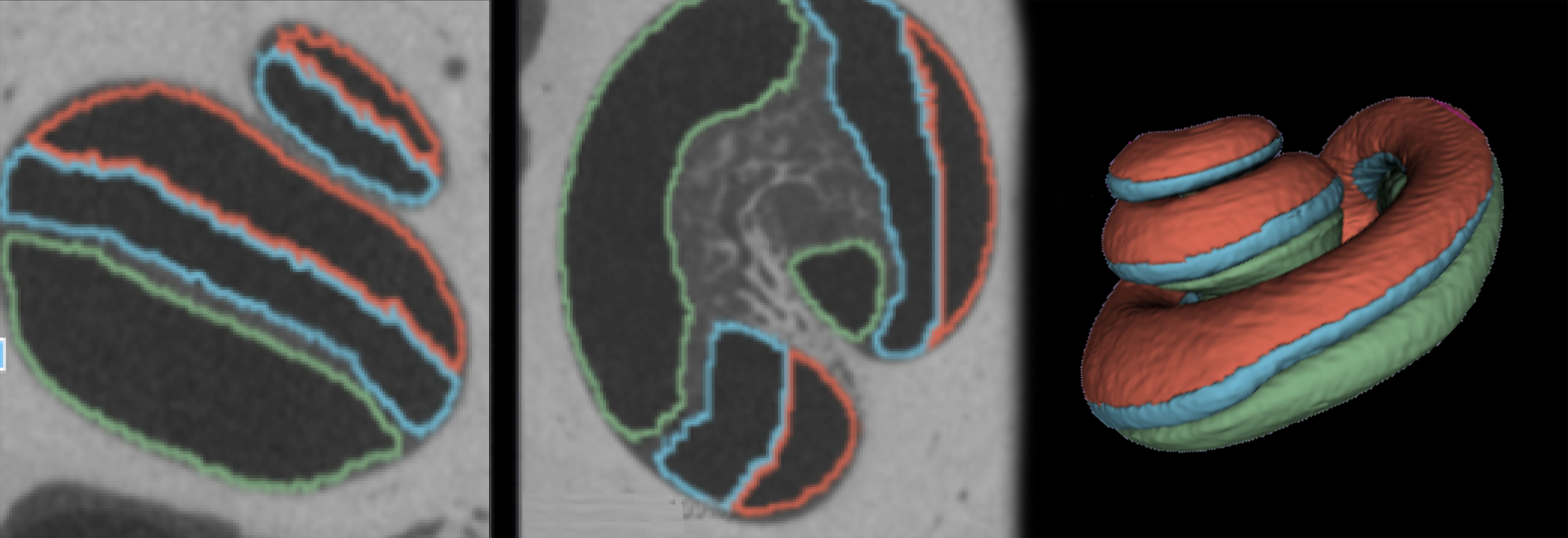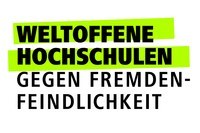Biophysics & Computer-Aided Medical Image Processing
Arbeitsgruppe
Inhalte
Die Arbeitsgruppe Biophysics & Computer-Aided Medical Image Processing kombiniert unterschiedliche Aspekte aus Biophysik, Modellierung und Bild- sowie Datenanalyse, um komplexe biologische Prozesse und medizinische Fragestellungen präzise zu untersuchen und zu optimieren. Mathematische und biophysikalisch-basierte Modelle geben dabei detaillierte Einblicke in molekulare und strukturelle Prozesse wie hämodynamische Flussmuster, während die Bild-, Sensor- und Datenanalyse essenziell für die Interpretation der gewonnenen Daten ist. Darüber hinaus werden hybride Ansätze in Kombination mit Technologien wie maschinellem Lernen und künstlicher Intelligenz verfolgt, um Bildanalyse und Modellgenauigkeit zu verbessern. Ziel der Arbeitsgruppe ist es, mithilfe dieser Verfahren neue Lösungsansätze für diagnostische und therapeutische Fragestellungen zu erforschen und klinisch verfügbar zu machen.
Projekte
Prof. Dr. Heiko Neeb
Quantitative MRT Diagnostik bei Multipler Sklerose
In unseren Forschungsprojekten steht die Biophysik und Dynamik von Wassermolekülen im Fokus, die spezifisch an Biopolymere wie Lipide oder Kollagen binden. Dabei werden Ansätze zur in vivo Quantifizierung der sogenannten Hydrationswasserkonzentration basierend auf der Kombination von MRT-Messungen und Molekulardynamiksimulationen erforscht.
Ziel ist es, diesen Parameter als sensitiven Biomarker für neurologische Fragestellungen, etwa bei Erkrankungen der weißen Hirnsubstanz wie multipler Sklerose, und für orthopädische Anwendungen im Zusammenhang mit Veränderungen der Kollagenstruktur zu nutzen. Aufbauend auf einem etablierten Modell zur physikalischen Beschreibung der Lipid-Wasser-Wechselwirkung soll die Methode zur präzisen in vivo Analyse weiterentwickelt werden. Gemeinsam mit Kooperationspartnern sind klinische Studien geplant, um das Verfahren für neurologische und orthopädische Fragestellungen nutzbar zu machen.
Prof. Dr. Peer Neubert
AI-DPA "Analyse und Interpretation von unstrukturierten Daten und Prozessen in zwei- und dreidimensionalen Anwendungsszenarien mit Machine Learning“ KI-Forschungskolleg in cooperation with University of Applied Science Mainz. (2023-2026)
MineSweeper: A research study on visual perception and optimization for localization and mapping in challenging and changing environments in the context of civil demining in cooperation with the BAAINBw. (2024-2027)
ViPRICE-2: A research project with the German Aerospace Center (DLR) and TU Chemnitz on Visual Place Recognition in Changing Environments. (2022-2025)
Dr. Sabine Bauer
Projekt PersonalizedExpand:
Entwicklung eines Rheologischen-Wirbelsäulen-Simulationsmodells mit realitätsnahen, parametrisierbaren Wirbelkörpern, zur Ableitung der Geometrie- und Ausrichtungsparameter für individualisierte Wirbelkörper-Ersatzimplantate
Projekt COMBS:
The cochlea is part of the auditory system and, as such, it is a very important part of the inner ear. It is responsible for the transfer of audio signals to the brain. Specific disorders of the cochlea can be solved only with a special implant. This implant is an electronic device which simulates the functionality of the cochlea.
Publikationen
Al-Dhamari, I., Bauer, S., & Paulus, D. (2018). Automatic Multi-modal Cervical Spine Image Atlas Segmentation: Using Adaptive Stochastic Gradient Descent. In A. K. Maier, T. M. Deserno, H. Handels, K. H. Maier-Hein, C. Palm, & T. Tolxdorff, Bildverarbeitung für die Medizin 2018: Algorithmen - Systeme - Anwendungen; Proceedings des Workshops vom 11. bis 13. März 2018 in Erlangen (pp. 303–308). Berlin: Springer Vieweg. doi:10.1007/978-3-662-56537-7_80
Al-Dhamari, I., Bauer, S., & Paulus, D. (2018). Automatic Multi-modal Cervical Spine Image Atlas Segmentation: Using Adaptive Stochastic Gradient Descent. In A. K. Maier, T. M. Deserno, H. Handels, K. H. Maier-Hein, C. Palm, & T. Tolxdorff, Bildverarbeitung für die Medizin 2018: Algorithmen - Systeme - Anwendungen; Proceedings des Workshops vom 11. bis 13. März 2018 in Erlangen (pp. 303–308). Berlin: Springer Vieweg. doi:10.1007/978-3-662-56537-7_80
Al-Dhamari, I., Bauer, S., Paulus, D., Lissek, F., & Jacob, R. (2017). ACIR: automatic cochlea image registration. In M. A. Styner & E. D. Angelini, Medical Imaging 2017: Image Processing; 12. - 14. February 2017; Orlando, Florida, United States (p. 1013310). Bellingham, WA: International Society for Optical Engineering. doi:10.1117/12.2254396
Blomenkamp, L., Kramer, I., Bauer, S., & Paulus, D. (2023). Efficient Generation of 3D Lumbar Spine Models: An Anatomy-Driven Approach with Limited Input Parameters. In M. Carli, F. Battisti, S. Lončarić, & S. Colonnese, Proceedings of the International Symposium on Image and Signal Processing and Analysis ISPA 2023: September 18-19, 2023 Rome Italy (pp. 228–234). New York, NY: IEEE Computer Society. doi:10.1109/ISPA58351.2023.10278898
Caverzasi E, Papinutto N, Cordano C, Kirkish G, Gundel TJ, Zhu A, et al. (2023) MWF of the corpus callosum is a robust measure of remyelination: Results from the ReBUILD trial. Proc Natl Acad Sci USA, 16;120(20), e2217635120.
Deckelnick, K., Herbert, P. J., & Hinze, M. (2022). A novel W1,∞ approach to shape optimisation with Lipschitz domains. ESAIM: Control, Optimisation and Calculus of Variations, 28, 2. https://doi.org/10.1051/cocv/2022003
Eulzer, P., Bauer, S., Kilian, F., & Lawonn, K. (2021). Visualization of Human Spine Biomechanics for Spinal Surgery. IEEE Transactions on Visualization and Computer Graphics, 27(2), 700–710. doi:10.1109/TVCG.2020.3030388
Garcke, H., Hecht, C., Hinze, M., & Kahle, C. (2015). Numerical approximation of phase field-based shape and topology optimization for fluids. SIAM Journal on Scientific Computing, 37(4), A1846-A1871. https://doi.org/10.1137/140976134
Garcke, H., Hecht, C., Hinze, M., Kahle, C., & Lam, K. F. (2016). Shape optimization for surface functionals in Navier-Stokes flow using a phase field approach. Interfaces and Free Boundaries, 18(2), 219-261. https://doi.org/10.4171/IFB/360
Garcke, H., Hinze, M., Kahle, C., & Lam, K. F. (2018). A phase field approach to shape optimization in Navier–Stokes flow with integral state constraints. Advances in Computational Mathematics, 44, 1345-1383. https://doi.org/10.1007/s10444-018-9604-4
Müller, P. M., Kühl, N., Siebenborn, M., Deckelnick, K., Hinze, M., & Rung, T. (2021). A novel p-harmonic descent approach applied to fluid dynamic shape optimization. Structural and Multidisciplinary Optimization, 64(6), 3489-3503. https://doi.org/10.1007/s00158-021-03041-2
Neeb H, Schenk J (2019). Multivariate prediction of multiple sclerosis using robust quantitative MR-based image metrics, Z Med. Phys. 29(3), 262-271
Schyboll F, Jaekel U, Weber B, Neeb H (2018). The impact of fibre orientation on T1-relaxation and apparent tissue water content in white matter, Magnetic Resonance Materials in Physics, Biology and Medicine 31, 501–510
Neeb H, Schenk J, Weber B (2012). Multicentre Absolute Myelin Water Content Mapping: Development of a Whole Brain Atlas and Application to Low-Grade Multiple Sclerosis, Neuroimage : Clinical 1(1), 121-130
Neubert, P. & Schubert, S. (2021) Hyperdimensional computing as a framework for systematic aggregation of image descriptors. In Proc. of IEEE Conference on Computer Vision and Pattern Recognition (CVPR). DOI: 10.1109/CVPR46437.2021.01666
Schlegel, K., Kleyko, D., Brinkmann, B.H., Nurse, E.S., Gayler, R.W., & Neubert, P. (2024). Lessons from a challenge on forecasting epileptic seizures from non-cerebral signals. Nature Machine Intelligence Challenge Accepted
Schlegel, K., Neubert, P. & Protzel, P. (2022) A comparison of Vector Symbolic Architectures. Artificial Intelligence Review. DOI: 10.1007/s10462-021-10110-3
Schyboll F, Jaekel U, Petruccione F, Neeb H (2019). Dipolar induced spin-lattice relaxation in the myelin sheath: A molecular dynamics study. Sci Rep., 15(9), 14813.
Schyboll F, Jaekel U, Petruccione F, Neeb H (2019). Fibre-orientation dependent R1(=1/T1) relaxation in the brain: The role of susceptibility induced spin-lattice relaxation in the myelin water compartment. Journal of Magnetic Resonance 300, 135–141.
Schyboll F, Jaekel U, Petruccione F, Neeb H (2020). Origin of orientation‐dependent R 1 (=1/T 1 ) relaxation in white matter. Magnetic Resonance in Med., 84(5), 2713–2723.








